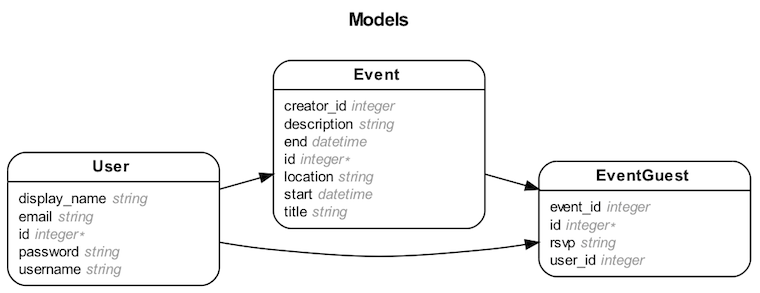Using RABL in Rails JSON Web API
Let’s use an event management app as the example.
The app has a simple feature: a user can add some events, then invite other users to attend the event. Its data are represented in 3 models: User, Event, and Event Guest.

Let say, we are going to add a read-only JSON web API for clients to browse data records from the app.
Problems
Model is not view
When working on a non-trivial web API, you will soon realize that, model often cannot be serialized directly in web API.
Within the same app, one API may need to render a summary view of the model, while another needs a detail view of the same model. You want to serialize a view or view object, not a model.
RABL (Ruby API Builder Language) gem is designed for this purpose.
Define once, reuse everywhere
Let say, we need to render these user attributes: id, username, email, display_name, except password.
In RABL, we can define the attribute whitelist in a RABL template.
# tryrabl/app/views/users/base.rabl
attributes :id, :username, :email, :display_nameTo show individual user, we can now reuse the template through RABL extends.
# tryrabl/app/views/users/show.rabl
extends "users/base"
object @user
## JSON output:
# {
# "user": {
# "id": 8,
# "username": "blaise",
# "email": "matteo@wilkinsonhuel.name",
# "display_name": "Ms. Noe Lowe"
# }
# }Here’s another example to show a list of users.
# tryrabl/app/views/users/index.rabl
extends "users/base"
collection @users
## JSON output:
# [{
# "user": {
# "id": 1,
# "username": "alanna",
# "email": "rubie@hayes.name",
# "display_name": "Mrs. Gaylord Hoeger"
# }
# }, {
# "user": {
# "id": 2,
# "username": "jarrell.robel",
# "email": "jarod@eichmann.com",
# "display_name": "Oran Lebsack"
# }
# }]The template can be reused in nested child as well, through RABL child.
attributes :id, :title, :description, :start, :end, :location
child :creator => :creator do
extends 'users/base'
end
## JSON output:
# {
# "event": {
# "id": 7,
# "title": "Et earum sed fuga.",
# "description": "Quis sed ..e ad.",
# "start": "2011-05-31T08:31:45Z",
# "end": "2011-06-01T08:31:45Z",
# "location": "Saul Tunnel",
# "creator": {
# "id": 1,
# "username": "alanna",
# "email": "rubie@hayes.name",
# "display_name": "Mrs. Gaylord Hoeger"
# }
# }
# }Join table rendered as subclass
I notice a recurring pattern in two recent projects. For instance, in this example, from client’s point of view, Event Guest is basically a User with an additional attribute: RSVP status.
When query database, usually we need to query the join table: event_guests.
class GuestsController < ApplicationController
def index
@guests = EventGuest.where(:event_id => params[:event_id])
end
endBut when rendering, the result set needs to be rendered as a list of Users. RABL allows you to do that easily, using its glue feature (a weird name though :).
# tryrabl/app/views/guests/index.rabl
collection @event_guests
# include the additional attribute
attributes :rsvp
# add child attributes to parent model
glue :user do
extends "users/base"
end
## JSON output:
# [{
# "event_guest": {
# "rsvp": "PENDING",
# "id": 3,
# "username": "myrna_harvey",
# "email": "shad.armstrong@littelpouros.name",
# "display_name": "Savion Balistreri"
# }
# }, {
# "event_guest": {
# "rsvp": "PENDING",
# "id": 4,
# "username": "adelle.nader",
# "email": "brendon.howe@cormiergrady.info",
# "display_name": "Edgardo Dickens"
# }
# }]I think I will use RABL for the next Rails web API project.
The complete Rails example code is available at github.com/teohm/tryrabl.